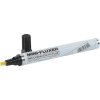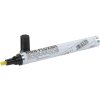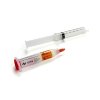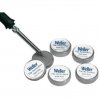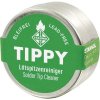How could I work without a flux so far? That´s a probable question of probably everyone, who once tried action of a solder flux. In a common wire solder, there´s some amount of a flux, usually sufficient for one-time soldering of a given joint, if the components to be soldered are clean and oxides-free. However, we know well a case, when we use for example an older PCB, or an older component with slightly oxidized leads and suddenly it´s much harder to reach an acceptable joint. Similar situation happens at an exchange of a component or any service action, when a solder tends to oxidize on a surface and create various bad-looking creatures, which are quite far from a professional joint. Fortunately, there´s a flux here ...
In general, fluxes act in a manner, that a solder is as if „more movable“ after application. It is mainly thanks to the protection against oxidation, change of surface tension and other influences. As a result it means, that a solder spreads well on metals and joints with a given material (what we naturally want) and on the non-metal substances (PCB) is a solder repelled as if on an oily surface.
At an automated „all-surface“ soldering, fluxes are usually applied by wetting (foam) or by spraying. At development and servicing smaller packages are much more practical, for example in a form of a pen. Two novelties in our offer also belong to this category:
● Stannol MINI-FLUXER X32-10i – halogen free, activated „No clean“ flux, practically residue-free, vey tolerant to various working conditions. Minimum amount of electrically safe transparent residues with a high insulation resistance enables its usage even at visible places and at production of highly reliable devices, including solar panels. Significantly eliminates build-up of bridges, that´s why it´s very suitable even for manual soldering of fine-pitch components.
● Stannol MINI-FLUXER X33S-07i – highly activated halogen-free „No clean“, resin-free flux, with a corrosion inhibitor, very suitable even for copper surfaces – clean, passivated or lacquered by rosin-based agents. Excellent wetting even on poorly adherent surfaces. Excellent spreading manifests by for example trouble-free filling of vias by a solder.
Stainless steel spring mechanism of a pen enables simple and precise dosage and also a long pen lifetime. During application, it´s only necessary to softly press on the tip. Both fluxes are in our stable stock offer, available immediately or in a short leadtime (in case of a temporary out-of -stock status).
Detailed information will provide you the Stannol-X32-10i and Stannol-X33S-07i datasheets.
In case of interest in any Stannol products, please contact us at info@soselectronic.com.
- 2 types of pen-type fluxes for soldering
- invaluable helper for development and service
- enables to reach first-class joints
- precise mechanism with an stainless steel spring
- quality „No clean“ fluxes with a minimum of residues
Do you like our articles? Do not miss any of them! You do not have to worry about anything, we will arrange delivery to you.















